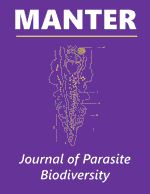Parasitology, Harold W. Manter Laboratory of
ORCID IDs
https://orcid.org/0000-0003-0819-7437 E. Hoberg
Date of this Version
1-17-2020
Document Type
Article
Citation
MANTER: Journal of Parasite Biodiversity (ISSN 2470-8224)
Occasional Papers, Number 11, January 17, 2020.
doi: 10.32873/unl.dc.manter11
Abstract
Tetrabothriid cestodes are characteristic helminths that infect species of seabirds globally. We begin with the exploration of the diversity of tapeworms of the genus Tetrabothrius Rudolphi, 1819 (Eucestoda: Tetrabothriidae), some of which are distributed among seabirds of the family Alcidae (Charadriiformes) at boreal to higher latitudes of Holarctic seas. During the course of 2 decades of field inventory from 1975 through the early 1990s (in addition to earlier collections assembled by Robert L. Rausch and colleagues in Alaska initiated in the late 1940s), an extensive series of tapeworm specimens attributable to species of Tetrabothrius was recovered from seabirds across the North Pacific Basin. It was assumed based on published records of species richness in this fauna that a single species, Tetrabothrius jagerskioeldi Nybelin, 1916, would predominate among alcid hosts. In contrast, detailed study revealed considerable morphological complexity that could not be accommodated within a single species. Further, it was apparent that the limits for the primary morphological attributes of T. jagerskioeldi were not clearly defined. We redescribe T. jagerskioeldi based on direct examination of the type series of specimens from Sweden and an assemblage of specimens largely from alcid hosts from the North Pacific basin. Specimens of T. jagerskioeldi are diagnosed by a characteristic configuration of the genital atrium, position of the male and female genital canals, structure of the male and female organ systems, and numbers of testes. Based on the spectrum of characters we explored, it was apparent that numerous specimens of Tetrabothrius among genera and species of Alcidae from the North Pacific inventory could not be accommodated in T. jagerskioeldi and provisionally are referred to Tetrabothrius undescribed n. sp. pending ongoing evaluations. Superficially, these are all large and robust tapeworms referable to Tetrabothrius, potentially contributing to misidentifications and misattribution that have occurred both in the literature and in the few archived specimens in museums. We summarize the results of extensive inventory collections since 1950, establishing a distributional baseline for species of Tetrabothrius from a wide range of geographic localities and an assemblage of host species among the Alcidae and some species of Laridae, Stercorariidae, and Phalacrocoracidae. We further evaluate the validity of historical published records for T. jagerskioeldi and other congeners among alcids and other seabirds. A conclusion that emerges is that T. jagerskioeldi is a rare tapeworm with a patchy distribution in pelagic to nearshore marine environments, showing considerable heterogeneity in space and time, among alcid seabirds across high-latitude seas of the Holarctic. Prior concepts for host range require reevaluation. We demonstrate that the associations for T. jagerskioeldi are relatively narrow and appear to involve a more limited spectrum of alcid hosts, and less often other species of marine birds, than currently assumed. A robust understanding of parasite species diversity and distribution is critical in establishing baselines across marine ecosystems. Our current study among species of Tetrabothrius, especially in the North Pacific basin and Bering Sea ecosystem contributes to development of a series of specimen-centered baselines derived primarily from the late 1970s to the early 1980s against which accelerating perturbations linked to climate warming and ocean-atmosphere interactions may be explored. Detailed knowledge of specimen-based faunal diversity for parasites provides a cumulative, temporal, and spatial snapshot and proxy for conditions in marine foodwebs and the continuity of trophic linkages.
Table 1
Hoberg 2020 MANTER Diversity of Tetrabothriidae Table 2.pdf (35 kB)
Table 2
Hoberg 2020 MANTER Diversity of Tetrabothriidae Table 3.pdf (94 kB)
Table 3
Hoberg 2020 MANTER Diversity of Tetrabothriidae Table 4.pdf (70 kB)
Table 4
Hoberg 2020 MANTER Diversity of Tetrabothriidae Table 5.pdf (18 kB)
Table 5
Hoberg 2020 MANTER Diversity of Tetrabothriidae SD Table 1.pdf (126 kB)
Suppl table 1
Hoberg 2020 MANTER Diversity of Tetrabothriidae SD Table 2.pdf (282 kB)
Suppl table 2
Hoberg 2020 MANTER Diversity of Tetrabothriidae SD Table 3.pdf (81 kB)
Suppl table 3


Comments
Copyright © 2020, Hoberg & Soudachanh. Open access license, CC BY-NC-SA 4.0 International.
Updated January 23, 2020.
The archive of record for nomenclatural acts in this journal is the Internet Archive.